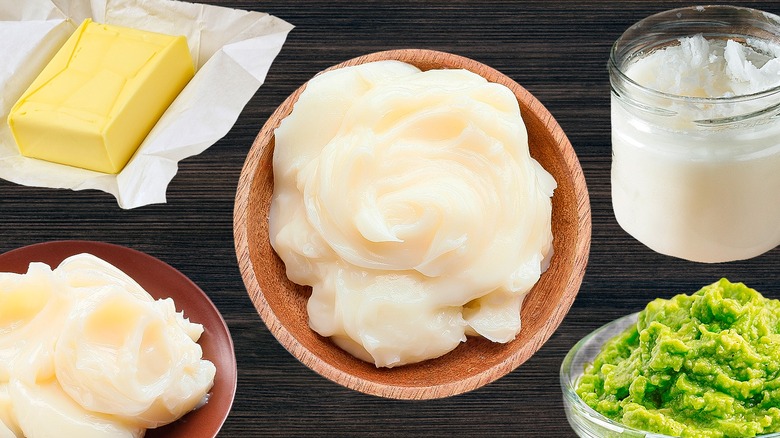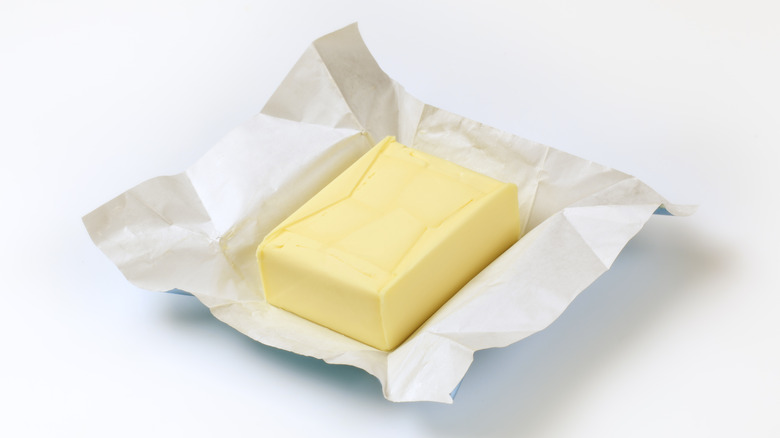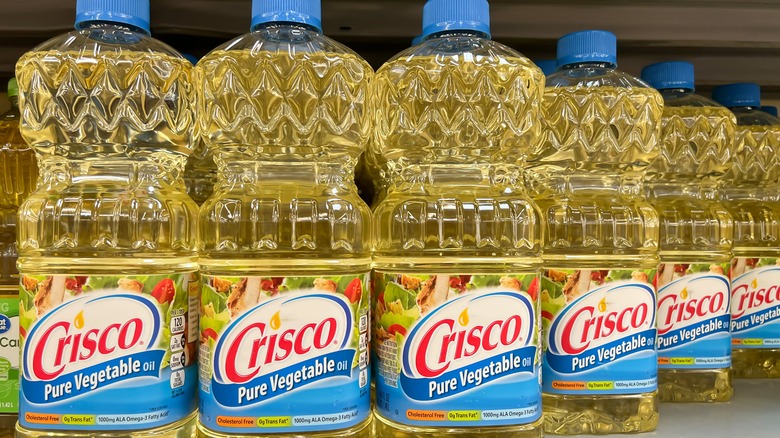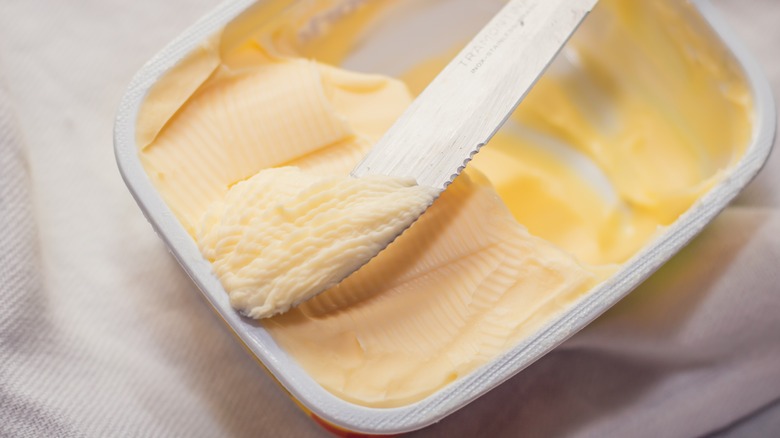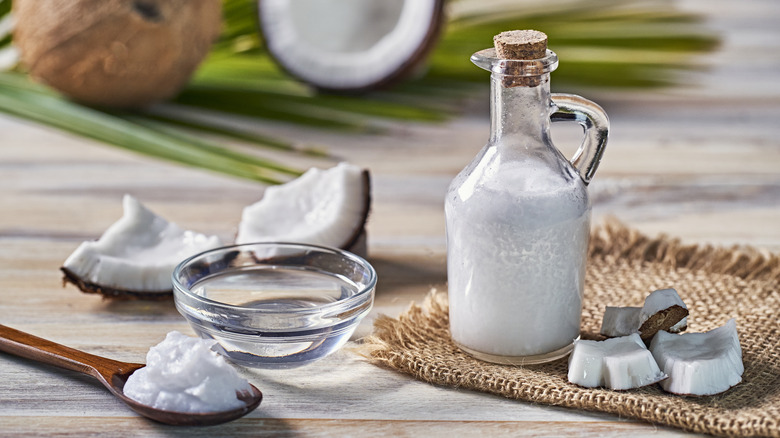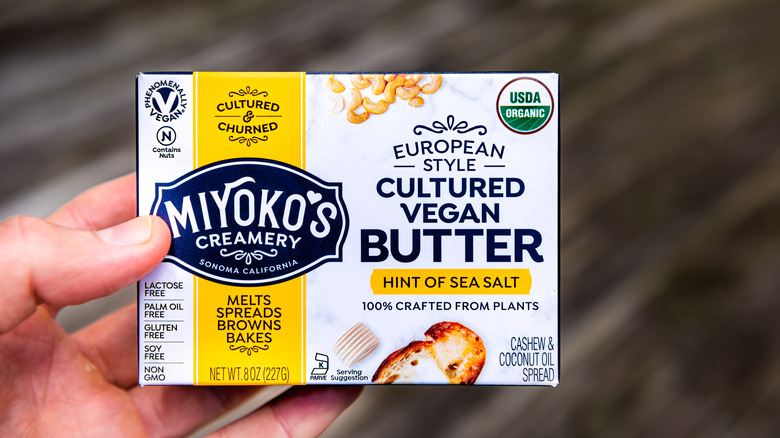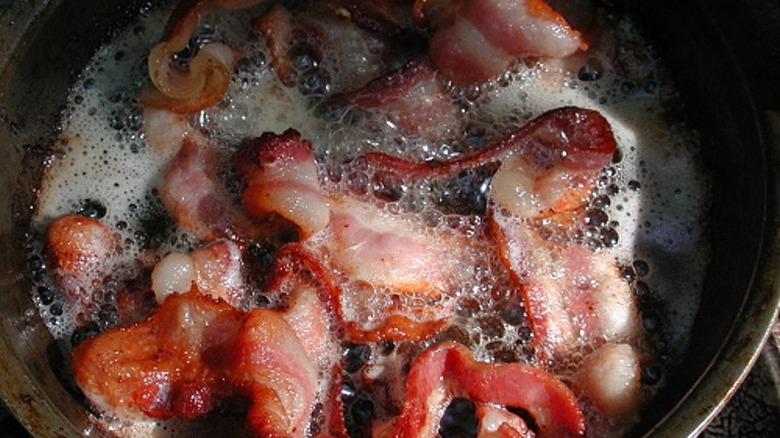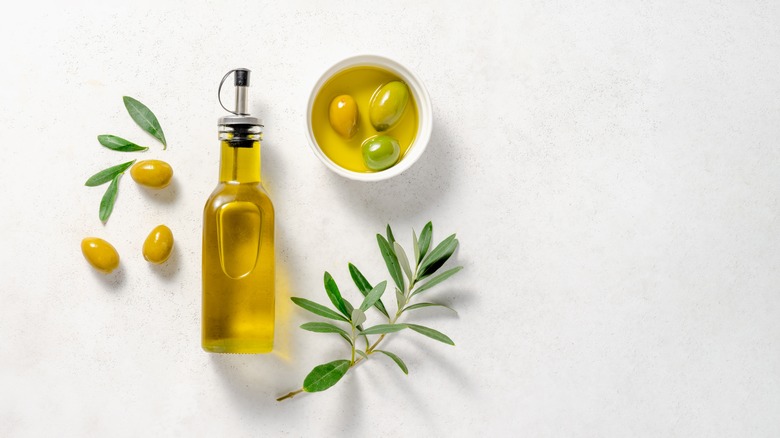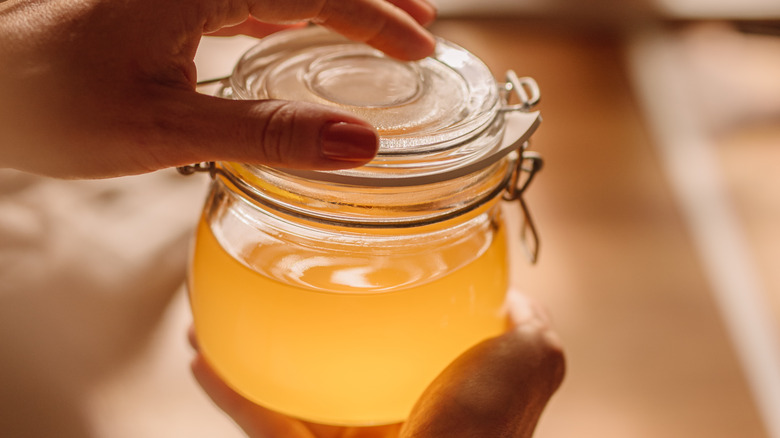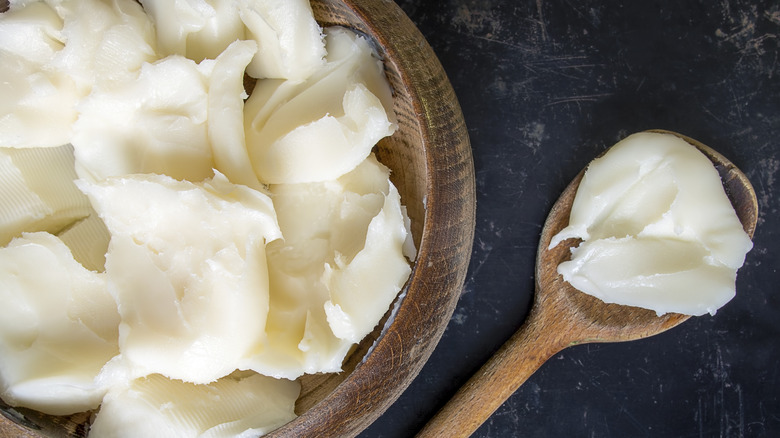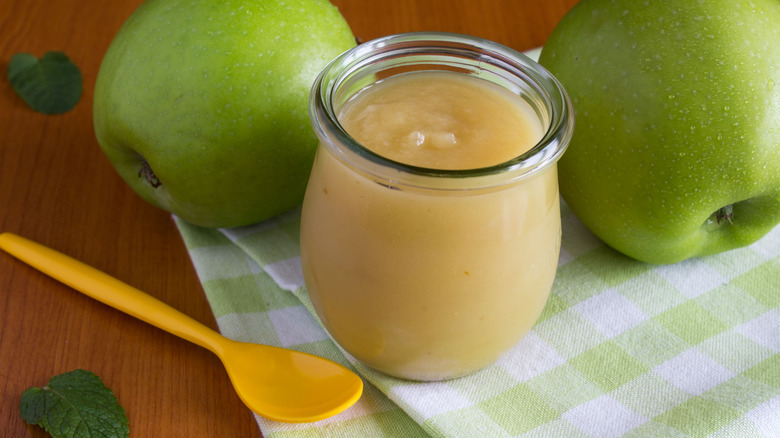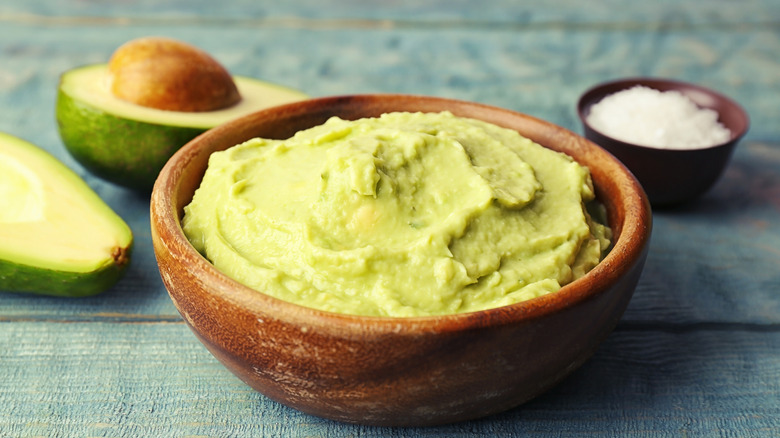11 Easy Substitutes For Shortening In Baking
If your baking recipe calls for shortening, it's likely referring to the commercially processed kind, like Crisco vegetable shortening, which is pure solidified fat with no moisture. This is because of the hydrogenation process the vegetable oils undergo. Although other brands make the same product, Crisco just happens to be the most well-known. Bakers often prefer shortening because of its neutral flavor, light color, and ability to make flaky, tender baked goods.
Not to mention, vegetable shortening is usually vegan, lactose-free, and gluten-free, so it checks many boxes for folks who have allergens or special diets. Believe it or not, some of the options on this list, like lard, technically count as a type of shortening since the true definition of shortening is solid fat, and it can be derived from animals, too.
But, more likely than not, if your recipe is something you found on Pinterest and not something you pulled out of the family recipe vault, vegetable shortening is what you need. Nevertheless, it's not the end of the world if you make your pastries with a different type of fat because they can still turn out just as delectable if you make some slight recipe changes. Whether you ran out of the canned shortening or prefer to use something different, all these options are suitable alternatives.
1. Butter
If you don't have shortening in your pantry, it's likely that you at least have butter in your refrigerator. You might think you can use these two products interchangeably without adjusting proportions, but that's actually false. It all comes down to the science of baking and how the fat and water content is different in butter versus shortening.
American butter usually only contains 80% butter fat, and the rest is water, aside from a small percentage of milk solids or salt sometimes. Butter also melts at a lower temperature than shortening does. This doesn't significantly affect your baked good, but it can have minor effects, like cookies that spread slightly more than usual or pie crust with a different flakiness level. You don't need to worry about flavor because it tastes much more decadent than shortening and supplements your desserts with its buttery flavor.
One thing to watch out for is if you use butter in recipes that are supposed to be vivid white, like white cakes or frosting. People often use shortening for these to get the brightest white possible, and butter can give them a yellow tint. Nevertheless, to properly use the butter as a replacement in your recipe, use 2 additional tablespoons for every 1 cup you use. For example, if a recipe requires 2 cups of shortening, use 2 cups plus 4 tablespoons of butter.
2. Vegetable oil
Since shortening is essentially processed vegetable oil, it's understandable why you can use regular vegetable oil as a fill-in. However, let's not forget that shortening is solid, and oil is liquid, so the oil slightly changes the consistency of the batter or dough you make. However, once you cook the baked good, the final product isn't too different, just denser.
Concerning flavor, it doesn't have an impact on it, which is good. This replacement is best for recipes that call for melted shortening or recipes where you combine the shortening with all of the liquid ingredients. For instance, it's ideal in a cake recipe where you have all of the dry components in one bowl and the eggs, shortening, and milk in the other before you mix everything together. Although, you can certainly use it in cakes that use the creaming method (where you mix the shortening and sugars until fluffy before you add the eggs). However, it lacks the airy texture you get from whipping the shortening until it's light.
The benefit of this swap is that oil is pure fat, like the shortening, so you don't have to worry about water content as you do with butter or margarine. Use this alternative with a one-to-one ratio, or use slightly less oil if you fear the baked good might turn out greasy.
3. Margarine
Margarine is another sufficient stand-in for shortening since companies make it from vegetable oil, and it's thick in consistency. But, don't be fooled; margarine isn't 100% fat; it usually has a similar composition as butter, with 80% being fat and the remaining ingredients being water, colorants, or preservatives. People often confuse butter and margarine because they taste and look very similar. The significant difference between the two is that manufacturers make butter from dairy.
Margarine sometimes contains traces of dairy (so it's not always vegan), but dairy is never the main ingredient. Regardless, because of the fat volume, you can add more margarine to the recipe when you substitute it for shortening. Like the butter, 2 tablespoons extra for every 1 cup does the trick. You can even use this product for frosting recipes if you wish. Bakers sometimes use shortening for frosting since it produces a stiffer texture and doesn't melt as quickly as other products.
However, it sometimes leaves you with a funky mouthfeel. If you want a dairy-free replacement to use in frosting, check the ingredients on your margarine because it might be able to save the day. Of course, you can also use it in pie dough, cakes, muffins, and more. Similar to shortening, margarine produces tender sweets, but they don't come out of the oven looking golden brown like you sometimes want them to. That doesn't mean you underbaked them, though. They just have a different look.
4. Coconut oil
This ingredient works because you can use it as a solid or a liquid in recipes, it is a comparable color to shortening, and it is 100% fat. However, one of the tips you need to master when you cook with coconut oil is knowing the difference between unrefined and refined versions. In short, the unrefined kind has a distinct coconut taste, so it's good to know which kind you have. It's best for recipes with ingredients that complement the coconut flavor the oil passes on to the baked good.
For example, use it in desserts with chocolate, strawberries, pecans, lemons, or caramel. On the other hand, refined coconut oil has a mild taste, so you might want to lean more toward that if you think your dessert ingredients clash with coconut flavor. When you use this as a shortening alternative, it's neat because you use the same amount as the original recipe calls for, so there is no math involved.
Although it's technically possible to make icing or glaze with coconut oil instead of shortening, it certainly works better in things you bake. Namely, coconut oil is fantastic for pie crust because it makes it flaky. In the dough, the little pieces of coconut oil have a high melting point, so they evaporate and create steam, which gives the crust a soft yet pleasant texture.
5. Vegan butter
Another viable option to use is vegan butter, which companies usually make with a variety of different plant-based ingredients. For instance, some manufacturers make it with almonds, cashews, avocado oil, soybeans, olive oil, and more. Plant butter often has a nostalgic taste of butter, although it contains plant ingredients. This is an appropriate option because it's solid, so you can use it in recipes that call for shortening in its natural form.
The good news is that you can also warm the vegan butter for recipes that require melted shortening, so it works both ways. The ratio for this replacement isn't black-and-white because it comes down to the individual brand you buy. Some plant butter brands might work at a one-to-one ratio, while with others, you might need to add more than you would the shortening. You can go to the company's website to find out or simply experiment, which might take some trial and error.
Some brands, like Country Crock, make the plant butter into sticks, making measuring quick and easy. Either way, the plant butter yields a slightly different texture and taste in sweets, but that doesn't mean it's in a bad way. The desserts still turn out delicious.
6. Bacon fat
Hear us out on this one because although it seems unconventional, it's a clever way to use up any extra bacon grease you might have. This ingredient also has the fattiness you're looking for when you want a shortening replacement. It works in baked goods where you want a sweet and salty flavor, like maple bourbon bacon pecan pie. Or, an ultra-sugary dessert that can benefit from a savory touch. Then, of course, it's perfect for bakes that aren't naturally sweet, like biscuits, cornbread, or pot pie topping.
Clearly, you need to weigh the pros and cons when you pick this replacement for shortening since it has a strong bacon taste, but once you're past that, it's a dream because it makes the baked goods have a beautiful, soft crumb. Ideally, omit or reduce the salt from the recipe because the grease's natural saltiness covers that aspect. Concerning recipe proportions, you don't need to make any changes.
It's important to note that your bacon fat shouldn't have any actual meat bits in it. When the grease is still warm and liquidy after you cook the bacon, strain it to remove any impurities, which extends its shelf-life. It might go rancid prematurely if you skip this step, unfortunately. Of course, fresh grease is ideal, but it lasts for up to six months in the right conditions, so it doesn't affect your baked good if you use it as a substitute within that time range.
7. Olive oil
Just as with vegetable oil, olive oil works best for recipes where you need to melt the shortening or mix it with other liquids. However, olive oil is richer than different types of fat, especially if you buy fine-quality products. Depending on the kind you have, it might have fruity, floral, or even peppery notes. Don't let that scare you, though. It's better to have a full-bodied olive oil than a cheap one with a weird aftertaste.
Just know what flavor profile you are working with before using it for baking. Its taste shows in plain baked goods, for example, if you use it instead of shortening in a simple sugar cookie. But if you make something with chocolate, citrus, or other ingredients that take center stage, you don't need to worry about the olive oil taking over. In terms of texture, the bakes turn out denser than with shortening, no doubt, but that's because it is a liquid that changes the crumb's structure slightly.
One disadvantage when you use this swap is that sometimes the olive oil makes cupcakes and bread noticeably oily. So, to combat this, simply cut the amount by 25% in your recipe, and the bakes don't have an oily appearance or feel to them anymore.
8. Clarified butter
When you simmer the water and milk particles out of butter, it turns into clarified butter, which is nearly 100% fat that has a higher smoking point. Chefs use clarified butter more often for cooking than baking since it withstands high temperatures and makes more stable sauces and dressings. However, it's an excellent substitute for shortening since you don't need to change the recipe's proportions.
Furthermore, clarified butter produces a scrumptious buttery taste to bakes where the same amount of shortening doesn't provide that flavor, so that's a plus. A specific type of clarified butter is ghee, which has a slightly different process in how you make it. Instead of removing the butter solids immediately, you allow them to turn brown and release a nutty aroma. Then you strain the pieces out. So, the main difference between ghee and clarified butter is their flavor depth.
However, you can use either as a replacement for shortening. The only drawbacks are that clarified butter is golden yellow, so it might alter the color of the baked good. And not everyone has clarified butter sitting around in their house so they might opt for regular butter with water content just for the sake of convenience. Also, it's not the best option for pastries when you need to cut cold butter into the dry ingredients. Instead, use it in things like oatmeal cookies, breakfast quick bread, or blondies.
9. Lard
Before you ask: yes, there is a difference between bacon fat and lard, although they come from the same animal, which is a pig. The grease you get from cooking bacon has a distinct bacony flavor, while lard has a bland taste that doesn't affect the sweetness or saltiness of baked goods.
Manufacturers make lard using fat from various parts of the animal, with pork kidney fat being the most suitable for baking. Meanwhile, bacon grease typically comes from the belly. If you want to make your baked goods extra rich but don't want a super savory flavor, lard is a fantastic fill-in for shortening. In fact, many recipes used lard as the default fat back in the day. So, we can technically say that shortening is a replacement for lard. Before Crisco and other brands began to make commercial shortenings for home cooks, bakers would use lard to make tender pie doughs, fluffy scones, and other types of pastries.
Since it is solid at room temperature, entirely fat, and has neutral color and flavor, you're safe to use it in equal amounts as shortening, and it doesn't affect the food you bake. Naturally, the only downside is that not everyone likes having animal fat in their cake or other sweet treats, whether they live a plant-based lifestyle or simply would rather just work with a different replacement.
10. Applesauce
Applesauce is a convenient swap for shortening because it's slightly thicker than liquids, like the oil options, and it has a naturally sweet taste. Therefore, it doesn't negatively affect the flavor of the baked goods, whether you use the sweetened or unsweetened kind. If you have a super sweet applesauce, you can reduce the sugar content in your dessert so it's not too sweet for your liking.
Furthermore, you can use this substitute for light-colored or dark-baked goods. However, it doesn't make desserts as fluffy in certain recipes, whereas shortening does. The applesauce makes things a bit denser, which is the only downside, but since it also provides moisture, it isn't a dry type of dense; it just makes things cakey. Surprisingly, although applesauce is relatively lightweight, you only need half as much as shortening.
So, if your recipe requires ½ cup shortening, you only need to use ¼ cup applesauce in its place. Use this swap in desserts like cookies, brownies, pumpkin bread, or cupcakes for best results. You can try it with full-sized cakes if you don't mind the slight difference in texture.
11. Fresh avocado
Although this likely isn't the first option that comes to mind when you need a swap for shortening, it's something to use because avocado has plenty of natural fats. It is also solid and has a creamy consistency, like shortening. People use avocado instead of butter, shortening, sour cream, or eggs in baking recipes, so it has many functions besides turning into tasty guacamole.
The best part about this substitute is that you don't need to change the recipe amount; simply swap it for a one-to-one ratio. You need to use a food processor to make a fresh avocado puree or mash it by hand if you don't own an appliance like that. Use a fork to break it down and make it as smooth as possible to avoid lumps in your dessert. However, it doesn't work in every single recipe that shortening does. You don't want to use it in frostings because the avocado turns brown after you expose it to oxygen, and it might have an unpleasant texture. The taste of the raw avocado is more noticeable than if you mix it into cookie dough or cake batter.
Use this replacement for things like muffins, banana bread, or cookies. Although the taste isn't strong, depending on what you make, it slightly alters the color of lighter baked goods. Another thing to watch out for is how it can make pastries brown faster, so you can always decrease the oven temperature slightly to prevent too much browning.
